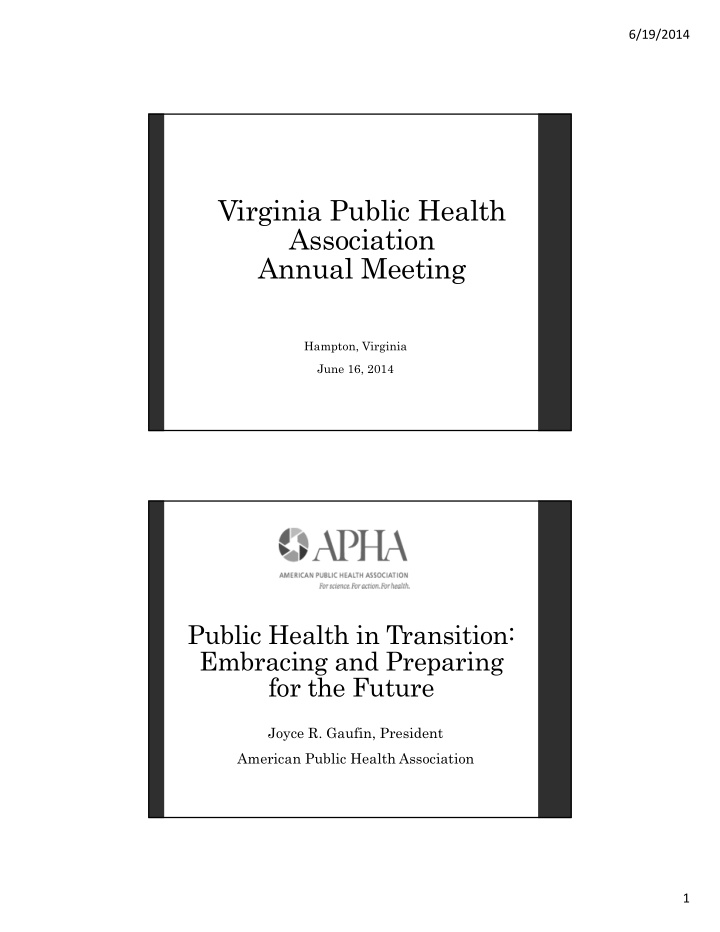



6/19/2014 Virginia Public Health Association Annual Meeting Hampton, Virginia June 16, 2014 Public Health in Transition: Embracing and Preparing for the Future Joyce R. Gaufin, President American Public Health Association 1
6/19/2014 Zion Nati Zion Nationa onal Park Park Snow Canyo Snow Canyon State Park State Park Dammeron eron Valley ey, U UT Supporting State Affiliates We need to: develop more leaders and improve leadership ability to advance our work engage members in more robust and effective advocacy for public health reach out to new (and different) partners and build more effective collaborations 2
6/19/2014 APHA and the Virginia PHA • Serving the public’s health • A place where everyone knows what you do! • Global, national, state, local perspective • Advocacy, professional development • Focused on priorities • Effective and sustainable organizations APHA’s 2013 Overarching Priorities • Creating health equity • Ensuring the right to health and healthcare • Building public health infrastructure and capacity 3
6/19/2014 APHA Values – November 2013 • Community • Science and evidence-based decision-making • Health equity/Social justice • Prevention and wellness • Real progress in improving health • For science. For action. For health. Global Health Equity “Our most basic common link is that we all inhabit this planet. We all breathe the same air; we all cherish our children’s future; and we are all mortal.” U.S. President John F. Kennedy 4
6/19/2014 IOM Report: IOM Report: U.S. is #17 U.S. is #17 Compared U.S. data with statistics from 16 peer developed countries Lagging behind other countries in life expectancy and health; expressed the gravity of the situation Institute of Medicine Report , January 2013 Social and Economic Conditions Social and Economic Conditi ns • Americans have higher average income Higher levels of poverty (especially for children), more income inequality, and lower rates for social mobility • Fewer safety net programs that can buffer the negative health effects of poverty and other social disadvantages 5
6/19/2014 Economic Costs of Health Inequities • Additional costs of health care incurred because of the higher burden of disease and illness experienced by minorities—was nearly $230 billion in the four years between 2003 and 2006. • When people are too sick to work, or die prematurely, there is loss of personal income, business productivity, and tax revenues— total cost to the U.S. was $1.24 trillion between 2003-and 2006. • 30.6% of direct medical care expenditures for African Americans, Asians, and Latinos were excess costs due to health inequalities . Source: Joint Center for Political and Economic Studies, The Economic Burden of Health Inequalities in the United States Social Injustice “Of all the forms of inequality, injustice in injustice in health care health care is the most shocking and inhumane.” - Dr. Martin L. King, Jr. 6
6/19/2014 Making the U.S. the Healthiest Nation Making the U.S. the Healthiest Nation In One Generation In One Generation Looking Upstream to Address Root Causes 7
6/19/2014 What is the Goal of HiAP? • Ensure decision makers are informed about the health, equity, and sustainability consequences of policy options during the policy development process. • Policy outcomes reflect those consequences. • Improve population health and equity. Intersectoral Collaboration Bring together partners from the many sectors that play a major role in shaping the economic, physical, and social environments in which people live: • Health and Human Services • Food • Parks and Recreation • Housing • Hospitals • Transportation • City Planning • Education • Human Resources • Environmental Protection • Interagency collaboration requires strong relationships that are built on a foundation of trust, mutuality, and reciprocity. • Focus on deep and ongoing collaboration. 8
6/19/2014 Historic Los Angeles County General Hospital In health there is liberty. Health is the first of all liberties, and happiness gives us the energy which is the basis of health. -- Henri-Frederic Amiel People don’t fall in love with a population! 9
6/19/2014 “The challenges are great….” - Remarks by Donald Berwick, MD Lack of confidence in science Need to use our global brains A lack of creativity for new ways to make effective and cost effective change Defending the poor—not popular The “miracle” of prevention Naming the excess spending in healthcare Vision Vi “Healthiest Nation in One Generation” Vision moves people forward Requires creativity, innovation, imagination You must engage others in the process Who are the ‘imagineers’ in the Virginia PHA? Story telling about how you will make a difference 10
6/19/2014 Importance of Relationships Importance of Relationships Most fundamental of all human needs Trust, respect, good communication Amplify the voice of individuals Learn to reach out to those who do not think and feel the same as you Passion for your work and service Passion for your work and service Reflect on the time when you first started working in public health…what motivated you? Nurture your passion “A small group of thoughtful people could change the world. Indeed, it’s the only thing that ever has.” -- Margaret Mead 11
6/19/2014 Lifelong Learning Lifelong Learning Ecological model for leadership development (Rowitz) Thinking critically, with an open mind Bringing others to the table by using all of your skills Much of this is more “art” than “science” Developing the Right Type of Leaders for the Future • Leaders need res resilience, cou courage, e, and and creativity eativity Building the stomach for the journey (Heifetz and Lewinsky) Model the way (Kouzes and Posner) Create an environment that encourages innovation and creativity Change your perspective (go to the balcony) 12
6/19/2014 13
6/19/2014 • Joyce R. Gaufin, President • American Public Health Association (APHA) • Email: gaufin646@gmail.com • Office phone: 435-574-2015 • Cell phone: 435-632-0911 14
Recommend
More recommend